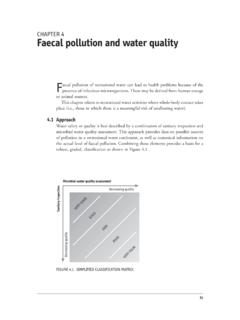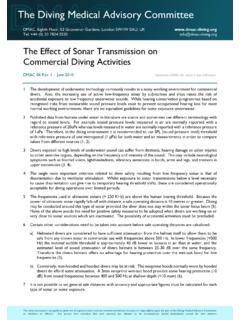Transcription of NES FOR SAFE RECREA Guidelines for Safe Recreational …
1 Guidelines for safe Recreational water ENVIRONMENTSVOLUME 2. SWIMMING POOLS AND SIMILAR ENVIRONMENTSWHOG uidelines for safe Recreational water Environments Volume 2: Swimming Poolsand Similar Environments provides an authoritative referenced review andassessment of the health hazards associated with Recreational waters of this type;their monitoring and assessment; and activities available for their control througheducation of users, good design and construction, and good operation andmanagement. The Guidelines include both specific guideline values and goodpractices. They address a wide range of types of hazard, including hazards leadingto drowning and injury, water quality, contamination of associated facilities andair preparation of this volume has covered a period of over a decade and has involved the participation of numerous institutions and more than 60 experts from20 countries worldwide.
2 This is the first international point of reference to providecomprehensive guidance for managing swimming pools and similar facilities sothat health benefits are maximized while negative public health impacts volume will be useful to a variety of different stakeholders with interests inensuring the safety of pools and similar environments, including national and localauthorities; facility owners, operators and designers (public, semi-public anddomestic facilities); special interest groups; public health professionals; scientistsand researchers; and facility 92 4 154680 8 Guidelines forsafe Recreational waterenvironmentsVOLUME 2 SWIMMING POOLS ANDSIMILAR ENVIRONMENTSG uidelines for safeGuidelines for saferecreational water environmentsrecreational water environmentsVOLUME 2: SWIMMING POOLS AND SIMILARVOLUME 2: SWIMMING POOLS AND SIMILARENVIRONMENTSENVIRONMENTS WORLD HEALTH ORGANIZATION2006layout safe 1layout safe 9:56 9:56:44 WHO Library Cataloguing-in-Publication DataWorld Health Organization.
3 Guidelines for safe Recreational water environments. Volume 2, Swimming pools and similar environments. pools standards quality analysis prevention and control and injuries prevention and control management values : Swimming pools and similar environments. ISBN 92 4 154680 8 (NLM classifi cation: WA 820) World Health Organization 2006 All rights reserved. Publications of the World Health Organization can be obtained from WHO Press, World Health Organization, 20 Avenue Appia, 1211 Geneva 27, Switzerland (tel.: +41 22 791 2476; fax: + 41 22 791 4857; email: Requests for permission to reproduce or translate WHO publications whether for sale or for noncommercial distribution should be addressed to WHO Press, at the above address (fax: +41 22 791 4806; email: designations employed and the presentation of the material in this publication do not imply the expression of any opinion whatsoever on the part of the World Health Organization concerning the legal status of any country, territory, city or area or of its authorities, or concerning the delimitation of its frontiers or boundaries.))
4 Dotted lines on maps represent approximate border lines for which there may not yet be full mention of specifi c companies or of certain manufacturers products does not imply that they are endorsed or recommended by the World Health Organization in preference to others of a similar nature that are not mentioned. Errors and omissions excepted, the names of proprietary products are distinguished by initial capital reasonable precautions have been taken by the World Health Organization to verify the information contained in this publication. However, the published material is being distributed without warranty of any kind, either express or implied. The responsibility for the interpretation and use of the material lies with the reader. In no event shall the World Health Organization be liable for damages arising from its use.
5 Design by minimum graphicsTypeset by Strategic communications SA, GenevaPrinted in Francelayout safe 2layout safe 9:56 9:56:45 ContentsContentsList of acronyms and abbreviations viPreface viiiAcknowledgements xExecutive summary xiiiCHAPTER 1. INTRODUCTION General considerations Types of pools Types of users Hazard and risk Types of hazard encountered Assessment of hazard and risk 6 Degree of water contact Measures to reduce risks Nature of the Guidelines References 10 CHAPTER 2. DROWNING AND INJURY PREVENTION Drowning Contributory factors Preventive and management actions Spinal injury Contributory factors Preventive and management actions Brain and head injuries Fractures, dislocations, other impact injuries, cuts and lesions Disembowelment Hazards associated with temperature extremes Injuries associated with feature pools References 22 CHAPTER 3.
6 MICROBIAL HAZARDS Faecally-derived viruses Hazard identifi cation Outbreaks of viral illness associated with pools 28 iiilayout safe 3layout safe 9:56 9:56 Risk assessment Risk management Faecally-derived bacteria Hazard identifi cation Outbreaks of bacterial illness associated with pools Risk assessment Risk management Faecally-derived protozoa Hazard identifi cation Outbreaks of protozoan illness associated with pools Risk assessment Risk management Non-faecally-derived bacteria Legionella spp. Pseudomonas aeruginosa Mycobacterium spp. Staphylococcus aureus Leptospira interrogans sensu lato Non-faecally-derived viruses Molluscipoxvirus Papillomavirus Non-faecally-derived protozoa Naegleria fowleri Acanthamoeba spp.
7 Plasmodium spp. Non-faecally-derived fungi Trichophyton spp. and Epidermophyton fl occosum References 53 CHAPTER 4. CHEMICAL HAZARDS Exposure Ingestion Inhalation Dermal contact Source water -derived chemicals Bather-derived chemicals Management-derived chemicals Disinfectants pH correction Coagulants Disinfection by-products (DBP) Exposure to disinfection by-products Risks associated with disinfection by-products Risks associated with plant and equipment malfunction References 76iv Guidelines for safe Recreational water ENVIRONMENTS layout safe 4layout safe 9:56 9:56:45 CHAPTER 5. MANAGING water AND AIR QUALITY Pre-swim hygiene Coagulation Disinfection Choosing a disinfectant Characteristics of various disinfectants Disinfection by-products (DBP) Disinfectant dosing Filtration Filter types Turbidity measurement Dilution Circulation and hydraulics Bathing load Accidental release of faeces or vomit into pools Air quality Monitoring Turbidity Residual disinfectant level pH Oxidation reduction potential (ORP) Microbial quality Other operational parameters Cleaning References 99 CHAPTER 6.
8 GUIDELINE IMPLEMENTATION Design and construction Operation and management Pool safety plan Lifeguards Public education and information Signage Education Regulatory requirements Regulations and compliance Registration and certifi cation schemes Conclusions References 113 APPENDIX 1. LIFEGUARDS 114 CONTENTS vlayout safe 5layout safe 9:56 9:56:46 List of acronyms and abbreviationsList of acronyms and abbreviationsAFR accidental faecal releaseAIDS acquired immunodefi ciency syndromeBCDMH bromochlorodimethylhydantoinBDCM bromodichloromethanecfu colony-forming unitCPR cardiopulmonary resuscitationCPSC Consumer Product Safety Commission (USA)
9 DBAA dibromoacetic acidDBAN dibromoacetonitrileDBCM dibromochloromethaneDBP disinfection by-productsDCAA dichloroacetic acidDCAN dichloroacetonitrileDMH dimethylhydantoinFAO Food and Agriculture Organization of the United NationsGAE granulomatous amoebic encephalitisHAA haloacetic acidHIV human immunodefi ciency virusHPC heterotrophic plate countHUS haemolytic uraemic syndromeHVAC heating, ventilation and air conditioningID50 infectious dose for 50% of the populationILSF International Life Saving FederationISO International Organization for StandardizationJECFA Joint FAO/WHO Expert Committee on Food Additives and ContaminantsLOAEL lowest-observed-adverse-effect levelMBAA monobromoacetic acidMCAA monochloroacetic acidNOAEL no-observed-adverse-effect levelNOEL no-observed-effect levelNTU nephelometric turbidity unitORP oxidation reduction potentialPAM primary amoebic meningoencephalitispfu plaque-forming unitQMRA quantitative microbiological risk assessmentTCAA
10 Trichloroacetic acidvi layout safe 6layout safe 9:56 9:56:46 TCAN trichloroacetonitrileTDI tolerable daily intakeTDS total dissolved solidsTHM trihalomethaneTOC total organic carbonUFF ultrafi ne fi lterUV ultravioletWHO World Health OrganizationLIST OF ACRONYMS AND ABBREVIATIONS viilayout safe 7layout safe 9:56 9:56:46 PrefacePrefaceThe World Health Organization (WHO) has been concerned with health aspects of the management of water resources for many years and publishes various documents concerning the safety of the water environment and its importance for health. These include a number of normative Guidelines documents, such as the Guidelines for Drinking- water Quality and the Guidelines for the safe Use of Wastewater, Excreta and Greywater.












